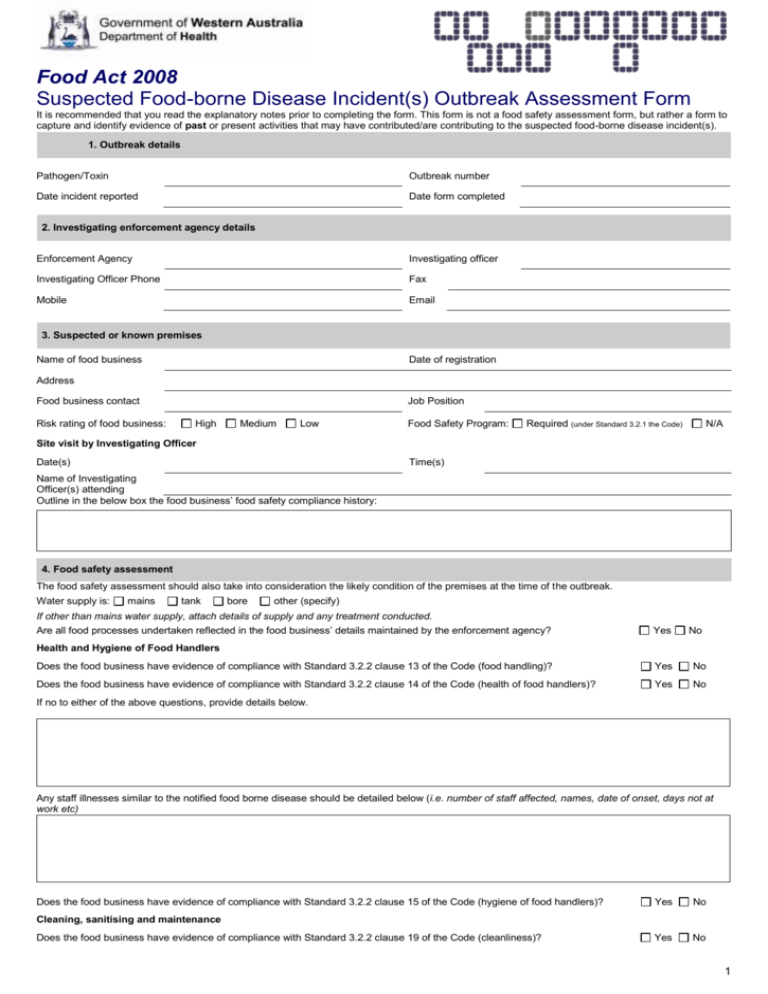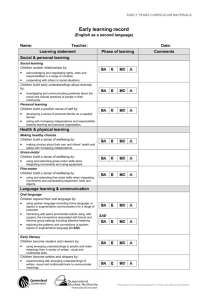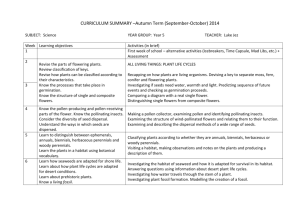Suspected Food-borne Disease Incident(s) Outbreak
advertisement

Food Act 2008 Suspected Food-borne Disease Incident(s) Outbreak Assessment Form It is recommended that you read the explanatory notes prior to completing the form. This form is not a food safety assessment form, but rather a form to capture and identify evidence of past or present activities that may have contributed/are contributing to the suspected food-borne disease incident(s). 1. Outbreak details Pathogen/Toxin Outbreak number Date incident reported Date form completed 2. Investigating enforcement agency details Enforcement Agency Investigating officer Investigating Officer Phone Fax Mobile Email 3. Suspected or known premises Name of food business Date of registration Address Food business contact Risk rating of food business: Job Position High Medium Low Food Safety Program: Required (under Standard 3.2.1 the Code) N/A Site visit by Investigating Officer Date(s) Time(s) Name of Investigating Officer(s) attending Outline in the below box the food business’ food safety compliance history: 4. Food safety assessment The food safety assessment should also take into consideration the likely condition of the premises at the time of the outbreak. Water supply is: mains tank bore other (specify) If other than mains water supply, attach details of supply and any treatment conducted. Are all food processes undertaken reflected in the food business’ details maintained by the enforcement agency? Yes No Health and Hygiene of Food Handlers Does the food business have evidence of compliance with Standard 3.2.2 clause 13 of the Code (food handling)? Yes No Does the food business have evidence of compliance with Standard 3.2.2 clause 14 of the Code (health of food handlers)? Yes No If no to either of the above questions, provide details below. Any staff illnesses similar to the notified food borne disease should be detailed below (i.e. number of staff affected, names, date of onset, days not at work etc) Does the food business have evidence of compliance with Standard 3.2.2 clause 15 of the Code (hygiene of food handlers)? Yes No Yes No Cleaning, sanitising and maintenance Does the food business have evidence of compliance with Standard 3.2.2 clause 19 of the Code (cleanliness)? 1 Additional information Are food safety records available, and if so, are they complete and accurate Yes No Were any other food safety assessment deficiencies (not already mentioned) identified during the food safety assessment? Yes No Summarise identified deficiencies below. Deficiencies include issues with temperature control, cross-contamination, cleaning and sanitising, personal hygiene, staff illness, FSP (if required) not on site, inadequate records etc. 5. Food history details Is a list of the food sold by the business available? (i.e. menu) Yes No If a menu is available, attach copy to form. Ensure all foods potentially served including any specials not on the regular menu, pre/post-dinner nibbles are listed. 6. General food processing details Does the food business have evidence of compliance with Standard 3.2.2 clause 7 (food processing)? This includes cook/chill and cook/freeze. If no, outline areas of concern below. Yes No NA In the investigating officer’s opinion, is there a food product or ingredient that presents a likely risk? Yes No NA If yes, provide details of the food products and/or ingredients. Describe the food processes involved using the product/ingredient in the template provided on page 6. (Investigating Officer is to obtain samples of any high risk foods identified during the investigation) 7. Food processing details of the ‘implicated foods’ or the ‘high risk foods’ identified If the outbreak food source is unknown, in the Investigating Officer’s opinion, is there a food product or ingredient that presents a likely risk? Detail the ingredient or components of the implicated food product(s) (including brand or batch): Describe the food processes involved in the preparation of ‘implicated food’ or ‘high risk food’ highlighting any factors that may have contributed to the contamination, including undercooking, cross contamination, shelf life and food storage temperatures. A food processing template is available on page 6. 2 Detail how many servings of the implicated food is sold daily: Is the implicated food sold to other food businesses or provided for catering? If yes, provide details: Yes No Yes (complete page 4) No 8. Food/water samples Were food/water samples or swabs collected and sent to PathWest? If yes, specify the name of the Investigating Officer who collected food samples/swabs and complete the Food and Environmental Sampling Record Sheet and Chain of Custody form on the following page 9. Additional comments Have any other food safety issues not detailed in this form been identified? If yes, provide details: Yes No e.g. Patron reported illness Detail any actions undertaken by the food business to prevent the ongoing occurrence of the outbreak known or suspected to be linked to this business: 10. Findings Do you reasonably believe that the identified areas/issues of non-compliance (listed in the above form) pose a food safety risk that could have contributed to the consumption of unsafe food? Investigating Officer Investigating Officer Yes Signature Signature No Date Date 3 Food and Environmental sampling record sheet and Chain of Custody Please photocopy this table if more samples were collected. All samples are to be submitted to PathWest with the appropriate PathWest Laboratory Submission Forms, noting the food investigations code F/003. Collected from (e.g. from case’s home, from food business etc.): __________________________________________________________________ Sample ID LD1/01 Date of sample collection 08/02/2012 Time of sample Sample type collection (food, water, swab) 11:30am Food Purpose for obtaining sample Description of item sampled What are the ingredients of the product sampled Confirm possible Mayonnaise temperature abuse “Homemade Mayonof PHF naise” – 1L batch made” Egg Olive oil Lemon Juice Salt Mixed herbs What are the Where collected brands/sources of and temperature the high risk ingredients Joe’s Southern Eggs Front display cabinet (10 °C) Date and time batch was made What is this product found in 01/02/2012 at 8am Chicken Burger Egg and Salad Roll Dip for chips Greenie Herbs Sampler name Mary Brown Relinquished by: Date: Time: Temperature: Received by: Date: Time: Temperature: Relinquished by: Date: Time: Temperature: Received by: Date: Time: Temperature: Relinquished by: Date: Time: Temperature: Received by: Date: Time: Temperature: Sampler signature MBrown 4 Suspected food-borne disease incident(s) onsite assessment form – explanatory notes These explanatory notes have been developed to assist Investigating Officer(s) in the collection of information needed to thoroughly investigate an incident. Note that not all questions are listed in the below explanatory notes as some questions do not require further explanation. Section 3. Suspected or known premises Are all food processes undertaken reflected in the food business approval? This question aims to determine if the food business is preparing food as detailed to the enforcement agency when notifying/registering the food business. For example, did the business originally intend to only sell low risk products (when registering) and are now preparing medium to high risk foods? Food preparation must also be suitable for the design of the food premises. Section 4. Food Safety Assessment Water supply If the water supply is anything other than mains water, attach additional details of the supply, and include details of any treatment of the water (e.g. how treated, what chemicals used, where treated, how often, when last treated and how is the water quality verified (i.e. testing records). Health and hygiene of food handlers This may be based on past history or issues identified during the site visit. Is there evidence of compliance with Standard 3.2.2 clause 13 of the Code (food handling)? The above questions aim to establish if there are any issues relating to food handling practices which may result in illness. Food handlers are required to take all reasonable measures not to compromise the safety and suitability of food. Is there evidence that food handlers are complying with Standard 3.2.2 clause 14 of the Code (health of food handlers)? Any details of food handlers that have reported illness to the food business must be recorded to establish if there is a link between the ill food handlers and food borne disease outbreak. Is there evidence of compliance with Standard 3.2.2 clause 15 of the Code (hygiene of food handlers)? The Investigating Officer should be satisfied that personal hygiene practices of food handlers are at a level that minimises the contamination of food. Is there evidence of compliance with Standard 3.2.2 clause 19 of the Code (cleanliness)? The above question aims to establish if the premises, fixtures, equipment and vehicles that are used to transport food are maintained at an acceptable level of cleanliness. Food safety assessment Were any deficiencies identified during the food safety assessment? The Investigating Officer should undertake a food safety assessment of the premises to identify any food safety deficiencies that may have contributed to the outbreak. These should not include structural items that do not impact on food safety. For example, a missing or non operational wash hand basin is considered a food safety issue as this demonstrates that food handlers are not able to maintain good personal hygiene. The Investigating Officer should record any deficiencies that could not be verified by the food business owner/operator. Section 6. General food processing details Is there sufficient evidence to demonstrate compliance with Standard 3.2.2 clause 7 (food processing)? The Investigating Officer should be satisfied that only safe and suitable food is produced, food is protected from contamination, if necessary, pathogens that may be present in the food are reduced to safe levels and that the time that food remains at temperatures that permit the growth of pathogenic micro-organisms is minimised. In the Investigating Officers’ opinion, is there a food product or ingredient that presents a likely risk? In some instances the implicated food causing an incident may not already be known. This question aims to identify a food product or ingredient that could have caused the incident(s). The Investigating Officer should ask the person preparing the food for the complete details of the food processes involved. This includes storage, preparation, display and when the food was served. This information should be verified by reviewing any food safety documentation. Information can be recorded on the template provided on page 6. Section 7. General food processing details Detail the ingredient or components of the implicated food product(s) (including brand or batch). Describe the food processes involved in the preparation of implicated food highlighting any factors that may have contributed to the contamination, including undercooking, cross contamination, shelf life and food storage temperatures. A food processing template is available on the next page. If an implicated food is known at the time of the onsite assessment, it is important to capture as much information as possible, including the processes used, batch and brand details. This information can be utilised to determine the cause of the food borne disease and also assist in the traceability of a product/ingredient. Section 8. Food/water samples Were food/water samples or swabs collected and sent to PathWest? The investigating Officer is encouraged to obtain multiple samples and swabs in order to investigate the food-borne disease incident(s). All water/food samples or swabs should be recorded on the Food/water Sampling Record Sheet (above). Section 10. Findings Do you reasonably believe that the identified areas/issues of noncompliance (listed in the above form) pose a food safety risk that could have contributed to the consumption of unsafe food? This question guides the Department of Health in their outbreak investigations to determine if further investigation is required or, if the food business investigated by the Investigating Officer(s) is linked to this/these food-borne disease incident(s). Section 5. Food history details Is a list of the food sold by the business available? A food business may be able to generate a list of all meals sold a week before the first person became ill. If this is not available, a menu from the restaurant (including any specials that may not appear on the regular menu pre/post-dinner nibbles and drinks supplied) or a list of foods served at a function, event or party should be obtained. This should also include food that a group may have brought to a function e.g. cake/sweets. In addition to this, a booking list of the persons whom consumed meals at the food business at the time of the alleged outbreak may be of assistance. 5 Food process template The below template provides a guide on the type of processing information that is to be collected of the implicated food or high risk product identified. It is important to obtain as much detail as possible. Note: Include brand names, batch numbers and/or use by dates where appropriate. Name of high risk or implement food: ________________________________________________________________________________________ PROCESS STEP DATE AND TIME Receival of goods at food business Storage of ingredients Processing - preparation Processing – cooling/heating (time temperature relationship) Storage after processing Processing - reheating Packaging Display Transport 6








